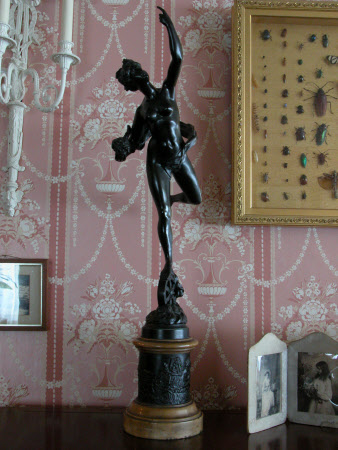Fortuna, the goddess of Chance
Chauvin (fl. c.1850 - 1900)
Category
Art / Sculpture
Date
c. 1850 - 1900
Materials
Bronze
Measurements
875 mm (H)
Place of origin
Paris
Order this imageCollection
Cragside, Northumberland
NT 1231007
Summary
Sculpture, bronze; Fortuna, goddess of Chance; Chauvin, French; c. 1850-1900. A statuette of the goddess Fortuna balancing upon a wheel. A pair to a figure of Mercury, after Giambologna.
Full description
A bronze statuette of Fortuna, the goddess of Chance. She is depicted naked except for a swag of drapery around her midriff that flutters out behind her, as she flies through the air. Her hair is carefully dressed, with a tiara at her forehead. Her right foot balances upon a wheel rising upon waves, her left leg raised behind her, her right hand cradling a cornucopia, symbol of abundance. She points the finger of her raised left hand into the air, towards the heavens. A fracture in the right leg, close to ankle. The inscription ‘Chauvin’ is in one of the waves. Mounted on a circular bronze base, with moulded sides, which is in turn mounted upon a yellow marble socle, the central stem of which is ringed by a bronze frieze featuring two scenes, one of a putto sculpting a portrait bust surrounded by instruments of the arts, the other with another putto drawing a torso, derived from designs by Carle van Loo (1705-1765). A pair to a figure of Mercury, after Giambologna (NT 1231006). Fortuna, the goddess of Chance, was often depicted in art from the medieval period onwards. She is often blindfolded and is usually depicted in an unstable position, balancing upon a sphere or a wheel, symbolising the uncertainty and inconstancy in the world’s fortunes. Especially in medieval art, the wheel is sometimes depicted with people attached to it, clambering up it or falling from it as the wheel turns. Often a powerful individual such as a monarch or bishop is shown descending towards the bottom. In the case of the present bronze, there is a small wheel and the woman carries a cornucopia, symbolic of abundance, somewhat diluting the goddess’s traditional iconography. The statuette, signed by a sculptor Chauvin, who remains to be identified but who must have been working in the latter decades of the nineteenth century, was specifically designed as a pair for the Mercury, the figure’s pose being an exact reflection of it in reverse. The bronze reliefs that adorn the socles of the Mercury and Fortuna are allegories of sculpture and drawing, showing small boys (putti) sculpting and drawing. They are distantly derived from a set of four celebrated paintings of Allegories of the Arts made by Carle van Loo (1705-65) for the great patron Madame de Pompadour (Xavier Salmon, ed, Madame de Pompadoour et les Arts, exh. cat., Musées nationaux de Versailles et de Trianon, Paris 2002, nos. 51-54), which depict young children engaged in the arts of painting, sculpture, architecture and music. The main design on the bronze reliefs on the Cragside bronzes is derived from the allegory of sculpture. The models are not uncommon and appear relatively frequently on the art market (for example, Bonham’s Edinburgh, 22 February 2017, lot 285). There are often however variations in the female companion figures, and in the attributes carried by both Mercury and Fortuna. Jeremy Warren March 2022
Provenance
Bequeathed to the National Trust by Mrs Veronica Mary Gibbs. Transferred to Cragside in June 1999.
Marks and inscriptions
Signed on clouds, near wheel:: Chauvin
Makers and roles
Chauvin (fl. c.1850 - 1900), sculptor Chauvaz , sculptor
